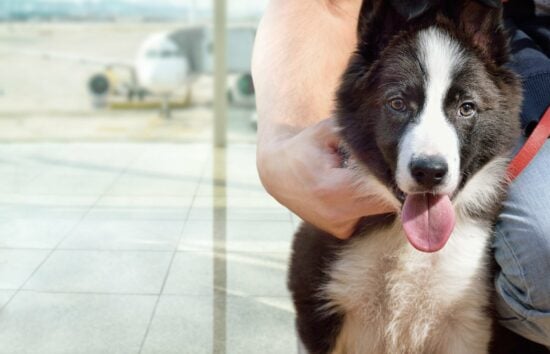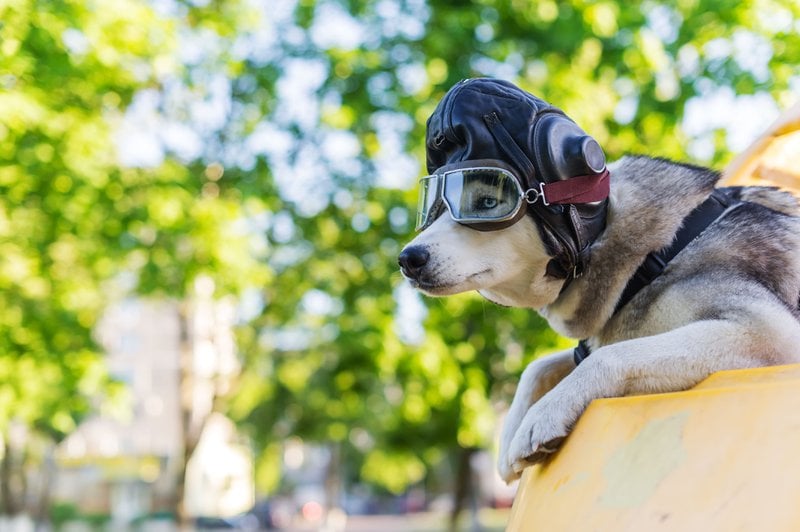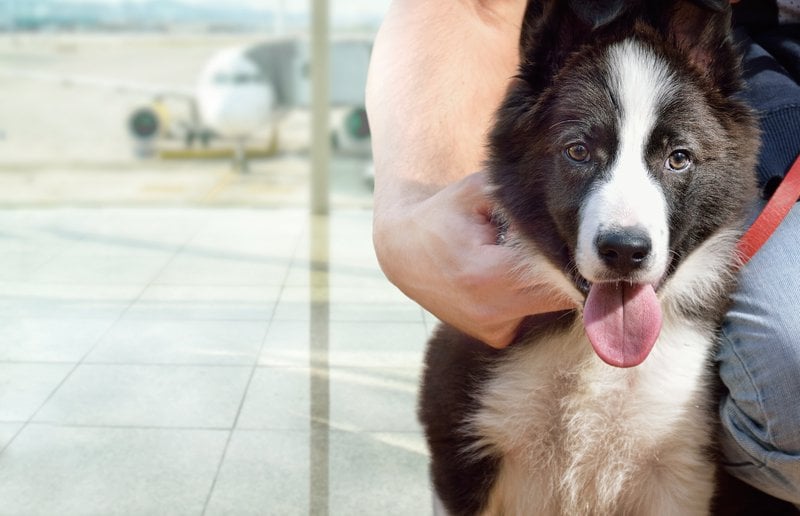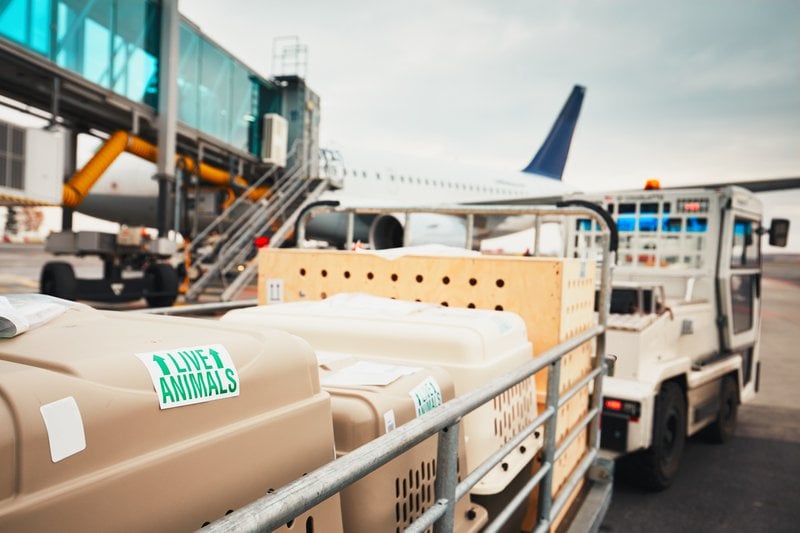While dog-lovers with smaller breeds can simply slip their furry friends into carry-on luggage, that is not easy to do when you have a Saint Bernard. But that does not mean you must leave your pet behind (which you want to avoid if you’re travelling alone or moving to a new city). Whether you are moving, taking a vacation, or going away on business, there are a variety of options for flying with a large dog. Here is what you need to know.
The Basics of Flying with a Large Dog
Flying with your furry friend isn’t as traditional as flying with a child. Understanding the right way to fly with a pet, especially large dogs, requires planning. It’s not something you want to figure out on the fly (pardon the pun) or wait until the day-of to figure out. Look into the airline you are flying with and figure out if they accommodate large dogs and what their policies are. Some airlines provide crates, but most require that you bring your own.
If you do not have a crate, you need to give yourself enough time to find and purchase a comfortable crate as well as train him or her not to panic when they are inside their crate. Ideally, your dog is properly crate trained. But, if not, they should at least have some familiarity with spending time in their crate. Even if you just buy the crate a week in advance and put your dog in it with treats for a few hours a day, that will help tremendously on the day you depart.
Three Ways Dogs Fly On Planes
- As Carry-Ons: Many smaller dog breeds and puppies are allowed to travel in carry-on luggage. Unfortunately, if you have a large adult dog breed, you will need to make other plans! Dogs usually need to be 20 lbs or less to fly with you inside the plane.
- As Checked Bags: The majority of airlines allow crated dogs to fly as checked bags. This means you will bring your dog’s crate to check-in like your other baggage, and he or she will be weighing and transported like the rest of the plane’s bags.
- As Cargo: Depending on the size of your canine and the airline you fly with, some may require that large dogs fly as cargo. This is not really something you need to worry about as you and your dog will still end up in the same place.
Can You Fly with Large Dogs?
Yes, you can fly with large dogs so long as they are properly crated and prepared to fly. Many airlines require your pet to be at least 8-weeks old before flying. Any younger and dogs are thought to be too fragile for long flights.
Your pet must also be free of fleas, ticks, and or infectious diseases. If you want to avoid the chance of your dog getting turned away at the airport, ensure that he or she is in a proper crate, clean, and as calm as possible—more on how to keep your dog calm while traveling later.
How Much Does It Cost?
You will pay around $125 each way to fly with a small dog in the cabin. To fly with a large dog in either bag check or cargo, the cost can range anywhere from $200 to over $1,000. This variability is why it’s so important to research or call the airline before you book tickets for your next trip.
There are a few factors that impact how much flying with a large canine will cost. These include:
- Cabin, checking, or cargo: Flying your dog through bag check is usually more expensive than as a carry-on, and cargo is more expensive than the other two options.
- National or international: As with ticket costs, flying your pet international is more expensive than domestic flights.
- Airline: It should come as no surprise that some airlines charge more than others.
- Destination: If you are traveling to a remote destination, or someone that only smaller planes go, flying with a pet may be more expensive.
- Dog Size: There is a difference between big dogs, say Golden Retrievers, and REALLY big dogs like Great Danes. If you have a REALLY big dog, he or she will likely need to fly cargo and may need other accommodations as well. This can cost extra.
Which Airlines Allow You to Fly with Large Dogs?
Most airlines will accommodate your pet in one way or another. Some of the better, more cost-effective airlines include Air Canada, Air France, American, Delta, Emirates, Hawaiian, Lufthansa, Sun Country, Swiss International and WestJet.
Air Canada
Air Canada is one of the more accommodating airlines when it comes to flying with large dogs. You can check your dog at baggage so long as it weighs 100 pounds or less. Any more, and it will need to go into cargo. The fees range from under $130 for domestic flights and under $320 for international.
Air France
Air France has somewhat strict K9 travel policies. Only non-snub-nose dogs under 30lbs are allowed to travel in the hold. And the fees can exceed $300.
American Airlines
American Airlines has clear policies when it comes to flying with large dogs. Animals weighing 100 lbs or less (including the weight of the carrier can travel for $200 and even less to certain destinations (like Brazil). Keep in mind that planes have limited room, and large dogs are granted access aboard American Airlines flights on a first-come-first-serve basis. So, if you want to ensure your dog a spot, make sure you show up early!
Delta Airlines
On Delta flights, all large pets travel in cargo for a fee of between $150 and $200. Keep in mind that if your flight is longer than 12 hours, you will need to talk to the airline about the health and safety of your pet and possibly make certain arrangements.
Emirates
Emirates is one of the more expensive airlines, charging between $500 and $800 per kennel. Large canines are, however, able to fly via checked baggage so long as the flight is 17 hours or less.
Hawaiian Airlines
Hawaiian Airlines allows dogs of up to 70 pounds (including the weight of the kennel) to be checked in with other baggage. Anything heavier must fly cargo. Prices vary but are typically around $450 or less.
Lufthansa
Large dogs can fly on Lufthansa in the cargo hold for between $150 and $400 depending on their size and the distance of the flight.
Sun Country Airlines
Sun Country Airlines has one of the simplest large dog policies: They fly as checked baggage and charge $200 per flight-segment.
Swiss International Airlines
Large dog fees range between $175 and $400 on Swiss International flights.
WestJet
WestJet has some of the cheapest dog policies, usually charging under $100 to fly with dogs as checked baggage.
Flying with Large Dogs Internationally
Yes, you can fly with a large dog internationally. You will, however, have to take a few extra steps. For example, you will need to get a stamp on your passport from the Department of Agriculture for your dog prior to boarding an international flight. Also, certain countries have other specific requirements.
Choosing the Best Crate
Your dog’s crate or kennel is key to how comfortable it will be while flying. Make sure you choose a spacious enough crate that allows your dog as much relaxation, comfort, and, of course, safety as possible.
Best Travel Carrier for Large Dogs
Most airline-friendly dog carriers are made from either rigid plastic and or welded metal. This is probably a good place to start when looking for a high-quality dog carrier. There are also plywood options that work and can be comfortable for your dog, but they typically weigh more and can end up pushing your dog over the weight limit at the baggage check, which means you will end up paying more. Usually, you are better off with plastic and or metal travel carriers.
Other things to think about when choosing a travel carrier for your large dog include:
- Size: Your dog should be able to turn comfortably, turn the way around in their travel crate. If they cannot, the crate is too small.
- Door: The door on a travel kennel should securely close and lock. Some canine kennels have a keypad or key locks. These are not a bad idea, as they may work to prevent any kind of foul play (like theft) that may occur if you have an especially expensive or prized pooch.
- Labels: Your dog’s travel kennel should include a prominent red and or a green sticker that is saying “Warning: Live Animal” or something of the sort. This will inform those in charge of loading and unloading your luggage that they should be extra careful.
Keeping Calm While Flying in a Crate
Depending on how anxious and used to being in a kennel your dog gets, you may want to consider anything from a sedative to simply covering their crate with a sheet. Usually, a darkened kennel or crate will help calm large dogs during transportation. However, if that does not work, you can talk to your vet about a mild sedative or try natural remedies.
Flying with Service and Emotional Support Dogs
Service or emotional support dogs are covered under the Americans with Disabilities Act. That means they are almost always allowed to fly in-cabin with their owners. If you have an especially large service or emotional support dog, however, it is better safe than sorry—you should, in other words, contact the airline prior to the day of your flight to make sure that you’re okay.
General Tips for Flying with a Large Dog
Here are a few valuable tips for flying with a large dog:
- Feed your dog between two and four hours of departure.
- Exercise your dog more than usual before your flight.
- Take your dog out to use the bathroom before you put them in their travel carrier.
- Put your dog’s favorite toy in their kennel.
- If the flight is longer than a few hours, include a bowl of ice or in your dog’s kennel. This will melt while your canine is in the cargo hold and give them something to drink.
Ensuring You Reunite with Your Dog
While airlines rarely lose dogs, it does occasionally happen. As with other important luggage, sometimes things are put on the wrong plane, and your dog is not there when you go to baggage.
If this happens, remain calm. Odds are, your dog will be returned to you, and everything will be fine. To ensure this happens, you will want to include a sticker with your name, phone number, address, and any other important information both on your dog’s crate and somewhere on their body (like on their collar).
You will also want to carry a picture of your dog with you on your person so that what you go to lost luggage, you have something to show them. Another thing you can do for added security is to get your dog a GPS tracking collar, so you know when he or she is at all times.
Conclusion
Now that you know how to fly with a large dog, you can start planning your next trip! Just remember to relax, plan ahead, and consider taking your dog with you the next time you go somewhere. So long as you are going somewhere pet-friendly, having your dog with you will only add to the fun!




